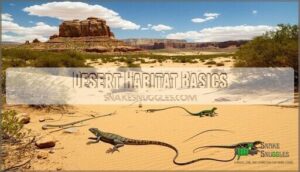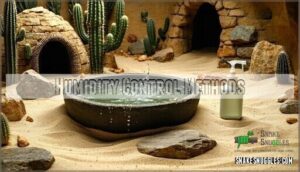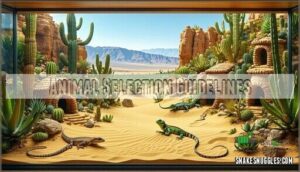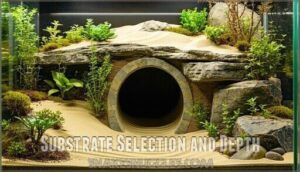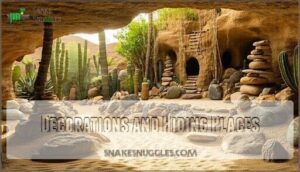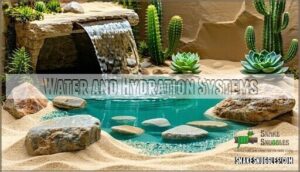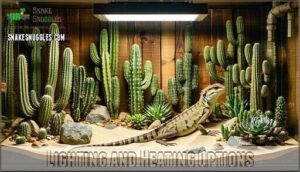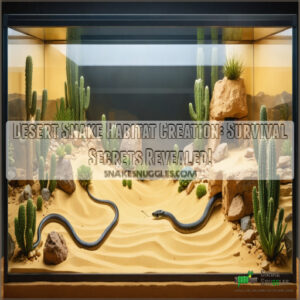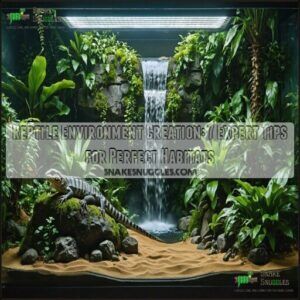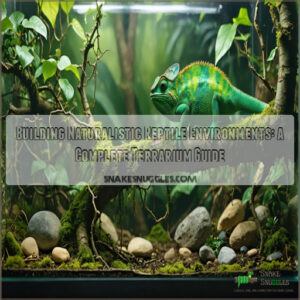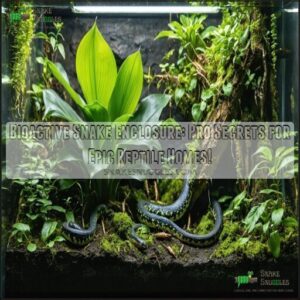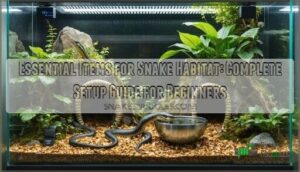This site is supported by our readers. We may earn a commission, at no cost to you, if you purchase through links.
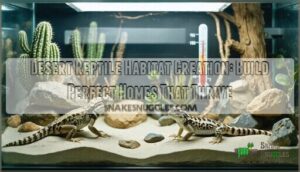
You’ll need an enclosure that’s twice your reptile’s length with proper ventilation—glass tanks offer visibility while plastic provides better insulation.
Essential elements include UVB lighting positioned 12-18 inches away, temperature gradients from 80-110°F, and sand-clay substrate mixtures for natural burrowing.
Desert species like bearded dragons and leopard geckos thrive in 20-40% humidity with hiding spots that mimic rock formations.
The key lies in replicating those scorching days and cool nights that define desert climates.
But there’s more to creating that perfect slice of the Sahara.
Table Of Contents
- Key Takeaways
- Choosing Right Enclosure
- Desert Habitat Basics
- Enclosure Design Principles
- Animal Selection Guidelines
- Setting Up Desert Habitat
- Lighting and Heating Options
- Maintenance and Health Checks
- Terrarium Enrichment Ideas
- Frequently Asked Questions (FAQs)
- How to set up a reptile habitat?
- How do reptiles live in the desert?
- How often should substrate be completely replaced?
- Can multiple desert reptile species cohabitate together?
- What signs indicate substrate mold or contamination?
- How to quarantine new reptiles before introduction?
- Which plants are safe for desert terrariums?
- What quarantine procedures are required for new reptiles?
- How do seasonal lighting changes affect desert reptiles?
- What emergency heating backup systems work best?
- Conclusion
Key Takeaways
- Size your enclosure properly – You’ll need a habitat that’s twice your reptile’s length, with adequate width for natural movement and thermoregulation.
- Create essential temperature gradients – Set up basking spots at 95-110°F and cool zones at 80-85°F, using heat lamps and ceramic emitters for proper thermal regulation.
- Install proper UVB lighting – Position full-spectrum UVB bulbs 12-18 inches from basking areas and replace them every 6-12 months for healthy calcium metabolism.
- Choose appropriate substrate and maintain low humidity – Use sand-clay mixtures 3-4 inches deep for natural burrowing, while keeping humidity between 20-40% with proper ventilation.
Choosing Right Enclosure
Selecting the right enclosure sets the foundation for your desert reptile’s health and happiness.
You’ll need to examine three critical factors: proper sizing, durable materials, and effective heating systems that replicate their natural environment.
The effective heating systems are crucial as they help replicate the natural environment of your desert reptile.
Enclosure Size Requirements
Your desert reptile habitat needs room to roam. Calculate Tank Dimensions using the twice-length, one-and-a-half-width rule for proper Space Allocation.
A three-foot snake requires six feet of Enclosure Depth minimum. These Size Calculations guarantee your reptile won’t feel cramped in their desert terrarium creation.
Adequate Reptile Length-to-space ratios prevent stress and promote natural behaviors in your reptile enclosure maintenance routine.
Proper enclosure maintenance involves understanding optimal enclosure requirements to create a thriving environment.
Material Selection Options
Glass tanks offer excellent visibility and easy cleaning, but they’re heavy and fragile.
Plastic enclosures provide lightweight durability with better insulation. Wood alternatives like PVC options resist moisture better than traditional lumber.
Mesh tops guarantee proper ventilation while maintaining security.
When selecting desert terrarium substrate, choose reptile-safe soil mixes that drain well. Your substrate selection impacts your pet’s health substantially.
Reptile owners should research suitable reptile tank options to create an ideal environment with proper ventilation.
Lighting and Heating Systems
Proper lighting and heating systems form the backbone of your desert reptile’s health.
UVB lighting supports calcium metabolism while heat sources create essential temperature gradients.
You’ll need fluorescent fixtures for consistent UVB exposure and heating elements for temperature regulation.
- UVB lighting – Install full-spectrum bulbs 12-18 inches from basking areas for ideal calcium absorption
- Heat gradients – Create basking spots at 95-110°F with cooler zones at 80-85°F using ceramic emitters or heat lamps
- Lighting cycles – Maintain 12-hour day/night cycles with thermostats controlling heating and lighting automatically
Desert Habitat Basics
Understanding desert environments is essential for creating authentic habitats that support your reptile’s natural behaviors.
Desert conditions feature extreme temperature swings, minimal humidity, and sparse vegetation that shape how these remarkable animals have evolved to survive, exhibiting natural behaviors in their habitats.
Characteristics of Desert Environments
Typically found in regions receiving less than 250mm of rainfall annually, desert environments create some of Earth’s harshest conditions.
Extreme temperatures swing from scorching 100°F+ days to near-freezing nights. These arid ecosystems feature sandy dunes, rocky outcrops, and sparse vegetation adapted to water scarcity.
Understanding these dry landforms helps you replicate authentic desert terrain for successful captive breeding programs.
Desert ecosystems are characterized by desert ecosystem conditions that support unique plant and animal adaptations, showcasing unique plant and animal adaptations.
Types of Desert Reptiles
Countless species call deserts home, each uniquely adapted to survive scorching days and freezing nights.
You’ll encounter fascinating creatures that’ve mastered extreme conditions through millions of years of evolution.
Popular desert reptile species include:
- Desert Snakes – Sidewinders and sand boas that navigate loose substrate with specialized movement
- Arid Lizards – Bearded dragons and leopard geckos thriving in low-humidity environments
- Sand Geckos – Nocturnal hunters with specialized toe pads for traction
- Desert Turtles – Hardy species requiring specific temperature gradients for proper shell development
Adaptations for Desert Survival
Desert reptiles have mastered survival through remarkable desert reptile adaptations.
These remarkable creatures have evolved incredible survival skills that put human ingenuity to shame.
Their nocturnal behavior helps avoid scorching daytime heat, while specialized heat resistance mechanisms protect against temperature extremes.
Desert camouflage provides protection from predators, and water conservation techniques prevent dehydration.
Thermal regulation through behavioral changes and physiological adjustments keeps them alive in harsh conditions with specialized heat resistance mechanisms.
Enclosure Design Principles
You’ll need three critical design elements to transform any enclosure into a thriving desert ecosystem for your reptile.
Proper ventilation, temperature gradients, and humidity control work together to replicate the harsh yet livable conditions your desert reptile has evolved to master.
Ventilation and Airflow Systems
Air Exchange becomes your reptile’s lifeline when replicating desert conditions.
Install mesh tops or screened panels to create proper ventilation systems that prevent stagnant air without losing heat.
Position vents strategically—intake near the cool side, exhaust by the warm zone.
This Airflow Control mimics natural desert winds while maintaining temperature gradients.
Breathable Materials like perforated panels guarantee Fresh Air Intake without compromising your arid ecosystem simulation, ensuring a proper Air Exchange.
Temperature Gradient Creation
Beyond simple heating, you’ll need strategic thermal zones throughout your enclosure.
Position heat sources at one end to create basking spots reaching 95-110°F, while the opposite end stays cooler at 75-85°F.
This gradient lets your reptile regulate body temperature naturally, mimicking desert conditions where they’d move between sun and shade.
To achieve ideal results, consider the importance of a proper temperature gradient setup for your reptile’s health.
Humidity Control Methods
Managing moisture levels in your desert reptile habitat requires precise control techniques.
Use spray bottles for occasional light misting to simulate rare rainfall. Water bowls provide constant hydration while humid hide boxes create moisture pockets for shedding.
Mist systems and fog machines offer automated humidity distribution, though most desert species need minimal moisture.
Monitor levels carefully to prevent respiratory issues and ensure the health of your reptiles, as precise control is crucial in their habitat.
Animal Selection Guidelines
Choosing the right desert reptile requires matching species needs with your setup capabilities.
You’ll need to take into account each animal’s adult size, activity patterns, and space requirements to create a thriving habitat, considering factors such as complete concepts to ensure the best environment for your reptile.
Suitable Reptile Species for Desert Habitats
Several beginner-friendly species make excellent choices for your first desert habitat.
Each offers unique benefits while remaining manageable for new reptile keepers.
Top Desert Reptiles for Beginners:
- Bearded dragons – calm temperament, easy handling, moderate adult size
- Leopard geckos – minimal handling needs, simple dietary requirements
- Kenyan sand boas – docile desert snakes, straightforward care
- Uromastyx lizards – hardy species, fascinating behaviors
Consider temperament concerns and handling needs when selecting your reptile companion.
Animal Size and Enclosure Size Ratio
Your reptile’s adult size determines the minimum enclosure dimensions needed for healthy living. Calculate space requirements using your pet’s full-grown length as the baseline measurement.
| Reptile Length | Minimum Enclosure Length | Minimum Enclosure Width |
|---|---|---|
| 12-18 inches | 36 inches | 18 inches |
| 24-36 inches | 72 inches | 36 inches |
| 48+ inches | 96+ inches | 48+ inches |
Growth considerations matter when selecting your desert habitat setup, as juveniles will outgrow smaller spaces quickly, which affects their overall growth and requires careful planning for enclosure dimensions.
Reptile Activity Level and Space Requirements
Three key Activity Levels shape your reptile habitat needs.
High-energy species like bearded dragons require spacious enclosures with multiple temperature zones for proper thermoregulation.
Moderate-activity geckos need smaller spaces but benefit from vertical Enclosure Enrichment.
Low-activity snakes utilize minimal Space Utilization efficiently.
Understanding Species Differences in Behavioral Needs guarantees your desert habitat meets each reptile’s unique movement patterns and environmental requirements.
Setting Up Desert Habitat
Now you’ll transform your empty enclosure into a thriving desert ecosystem by carefully selecting the right substrate, decorations, and water systems.
These three foundation elements work together to create the temperature gradients, security, and hydration your desert reptile needs to flourish, which are essential for creating a suitable environment with the right substrate.
Substrate Selection and Depth
In choosing desert substrate, you’ll find sand mixed with clay creates the perfect foundation for your terrarium.
Fine particle size allows natural burrowing behavior while preventing impaction risks.
Layer substrate three to four inches deep – enough for digging without excessive moisture retention.
Desert substrate types include reptile-safe sand, crushed walnut shells, or specialized terrarium substrate blends that replicate authentic desert habitat conditions.
Many retailers offer reptile substrate options for a variety of needs.
Decorations and Hiding Places
Strategic placement transforms your desert reptile enclosure into a thriving oasis.
Position Safe Materials like smooth river rocks and ceramic caves to create natural terrain.
Add Climbing Structures using sturdy branches for arboreal species.
Design hiding spots with stacked stones for Burrow Creation.
Mix textures and heights for Enrichment Variety.
These safe zones mimic Naturalistic Design, helping your desert habitat replicate authentic environments your reptile instinctively recognizes and explores.
Proper enclosure design, including escape-proof features, will further support natural behaviors.
Water and Hydration Systems
After establishing rocks and caves, you’ll need proper hydration systems for your desert reptile habitat creation.
Even desert species require daily water access to prevent rapid dehydration, especially smaller reptiles.
- Water dish size should match your reptile’s body length for easy drinking
- Misting frequency of 2-3 times weekly simulates natural dew formation
- Humidity hides with damp substrate create necessary microhabitat moisture zones
- Water source cleaning prevents bacterial buildup through weekly disinfection protocols
- Drip system installation provides moving water for species that ignore still sources
Hydration supplements aren’t typically needed with proper reptile hydration techniques and fresh water availability.
Lighting and Heating Options
Getting your desert reptile’s lighting and heating right is essential for their health and happiness.
You’ll need to balance UVB lighting for proper calcium absorption with precise temperature control that mimics their natural desert environment, ensuring proper calcium absorption.
UVB Lighting for Calcium Metabolism
Your reptile’s bones depend on UVB lighting for proper calcium absorption and vitamin D3 synthesis.
Without adequate UVB exposure, desert species like bearded dragons develop metabolic bone disease.
Use high-output bulbs (10.0 or mercury vapor) positioned 20-50cm away, covering one-third of your reptile habitat.
Replace bulbs every 6-12 months for ideal reptile health and calcium metabolism.
Heat Sources and Temperature Control
When desert reptiles need heat, you’re basically recreating the sun’s power in their glass world.
Heat lamps and ceramic emitters work best for basking spot design, while under-tank heaters provide steady warmth.
Your heat gradient importance can’t be overstated:
- Basking zones reaching 95-110°F for thermal regulation
- Cool areas maintaining 80-85°F for temperature control
- Nighttime temperature drops to 70-75°F mimicking natural desert habitat cycles
Emergency heat sources like backup ceramic heaters prevent dangerous cold snaps.
Thermometer and Thermostat Use
Accurate temperature monitoring forms the backbone of successful desert reptile care. You’ll need both thermometers for tracking and thermostats for automatic control.
Digital models with remote probes give you precise readings from basking spots and cool zones without disturbing your reptile. A proper setup requires understanding ball python heat needs.
| Equipment Type | Temperature Range | Key Features | Best Use |
|---|---|---|---|
| Digital Thermometer | -10°F to 200°F | Remote probes, memory function | Temperature monitoring daily |
| Infrared Gun | 32°F to 1022°F | Instant readings, surface temps | Quick spot checks |
| Thermostat Controller | 32°F to 140°F | Safety shutoffs, probe placement | Temperature regulation automation |
| Wireless Monitor | -40°F to 158°F | Remote monitoring, alerts | Long-term temperature accuracy |
Place probes at basking spots and cool areas for proper temperature gradients. Thermostat calibration prevents dangerous overheating while safety features protect your reptile’s temperature needs. This ensures a healthy environment for your desert reptile.
Maintenance and Health Checks
Your desert reptile’s health depends on consistent care routines that catch problems early.
Consistent care is your reptile’s insurance policy against costly health emergencies
Think of maintenance as your reptile’s insurance policy—regular cleaning schedules and health checks prevent costly emergencies down the road, which can be considered as part of a larger maintenance plan.
Daily and Weekly Cleaning Schedules
Once you’ve got your heating and lighting dialed in, keeping things clean becomes your next priority.
A dirty habitat spells trouble for your desert dweller faster than you’d think.
Your cleaning routine breaks down into three main tasks:
- Spot cleaning daily – Remove uneaten food, waste, and shed skin immediately
- Deep cleaning weekly – Disinfect water dishes and replace substrate as needed
- Full enclosure sanitization monthly – Clean all surfaces with reptile-safe disinfectants
Regular cleaning prevents bacterial buildup that can make your reptile sick.
Desert habitat cleaning doesn’t have to be overwhelming – just stay consistent with these basics.
Health Monitoring and Veterinary Care
Beyond clean tanks comes the watchful eye. Your scaly friends won’t tell you they’re sick—they’re masters at hiding illness signs until it’s almost too late. Annual checkups with an exotic vet catch problems early, while you play detective daily.
Watch for subtle changes in appetite, hiding behaviors, or irregular shedding. Quarantine protocols keep new arrivals separate for 3-6 months, preventing disease spread. Parasite control through fecal screenings and preventative care beat emergency first-aid situations. Desert reptile veterinary care requires specialists familiar with these unique species’ needs.
| Health Monitoring | Frequency | Action Required |
|---|---|---|
| Weight tracking | Weekly | Record changes over 10% |
| Behavioral observation | Daily | Note appetite, activity shifts |
| Professional exam | Annually | Schedule exotic vet checkup |
Diet and Nutrition Requirements
Proper nutrition fuels your desert reptile’s vitality and longevity.
Feed crickets, mealworms, and feeder mice based on prey size guidelines—nothing larger than your reptile’s head width.
Insect gutloading with nutritious foods 24 hours before feeding enhances nutritional value.
Vitamin supplementation twice weekly prevents deficiencies.
Adjust feeding frequency by species and age.
Maintain hydration methods through water dishes and occasional misting for ideal reptile nutrition.
Consider the potential harm of extreme diets, as nutrient deficiencies are possible if their dietary needs aren’t properly met to avoid deficiencies.
Terrarium Enrichment Ideas
You’ll transform a basic desert terrarium into a thriving ecosystem that keeps your reptile both physically active and mentally engaged.
Smart enrichment choices replicate natural desert conditions while encouraging your pet’s instinctive behaviors like climbing, burrowing, and territorial exploration, which promotes natural desert conditions.
Creating Naturalistic Environments
Your desert habitat’s success hinges on biotope authenticity that mirrors natural processes found in wild environments.
Creating aesthetic harmony requires careful attention to behavioral cues your reptile displays in response to sensory enrichment.
- Layer substrates with varying textures—fine sand, coarse gravel, and rocky outcrops
- Position branches and rock formations to create climbing opportunities and thermal gradients
- Add drought-resistant plants like succulents to enhance the desert environment’s realism
This reptile habitat design approach transforms basic reptile enclosure design into thriving desert reptile habitat design ecosystems.
Providing Mental Stimulation and Exercise
You’ll release your reptile’s natural instincts by incorporating enrichment items that challenge their minds.
Climbing structures like branches and rock formations encourage vertical exploration, while puzzle feeders make mealtime engaging.
Create foraging opportunities by hiding food throughout the habitat.
Rotate decorations regularly to provide sensory stimulation and prevent boredom, promoting natural behavior patterns including climbing and burrowing activities.
Simulating Desert Climate Conditions
Creating authentic desert conditions requires precise temperature gradients spanning 65°F to 110°F across your habitat.
You’ll maintain humidity levels between 10-30% using proper ventilation and substrate choice like sand-based materials.
Install 10-12% UVB lighting systems positioned 30-40cm from basking areas.
Temperature control through thermostats mimics natural seasonal variation, while strategic airflow prevents stagnation without disrupting your carefully crafted desert climate.
Frequently Asked Questions (FAQs)
How to set up a reptile habitat?
Choose a glass or PVC enclosure twice your reptile’s length.
Install UVB lighting, heat lamps creating 90-110°F basking spots, and cooling zones.
Add substrate, hiding spots, and water dishes for comfort.
How do reptiles live in the desert?
Like mirages shimmering on scorched sand, desert reptiles master survival through remarkable adaptations.
They’ve developed thick scales that lock in precious moisture, nocturnal hunting patterns that dodge blazing heat, and specialized physiology for extreme temperature swings—thriving where others perish.
They have effectively learned to master survival in environments that are hostile to most other creatures.
How often should substrate be completely replaced?
You’ll want to replace substrate completely every 3-6 months, depending on your reptile’s size and waste production.
Spot-clean weekly, but full replacements keep bacteria at bay and maintain proper drainage in your terrarium setup.
Can multiple desert reptile species cohabitate together?
Surprisingly, 80% of reptile cohabitation attempts fail due to territorial conflicts.
You shouldn’t house different desert species together—they’ll compete for resources, spread diseases, and stress each other out, ultimately compromising their health and well-being.
What signs indicate substrate mold or contamination?
You’ll spot white, fuzzy growth or dark patches on substrate surfaces. Musty, sour odors signal bacterial contamination. Substrate becomes clumpy, discolored, or develops a slimy texture when moisture accumulates excessively.
How to quarantine new reptiles before introduction?
Set up a separate quarantine tank for 30-90 days.
Monitor daily for illness, parasites, or stress behaviors.
Maintain proper temperatures and humidity.
Schedule a vet exam before introducing your new reptile to existing animals, this includes a vet exam and monitoring for stress behaviors.
Which plants are safe for desert terrariums?
Imagine your miniature desert blooming with life.
You’ll want hardy succulents like jade plants, snake plants, and aloe vera that thrive in arid conditions while staying non-toxic to your reptilian companions.
What quarantine procedures are required for new reptiles?
You’ll need to isolate new reptiles for 30-90 days in a separate enclosure.
Monitor for parasites, respiratory issues, and abnormal behavior while providing proper heating, lighting, and veterinary examination.
Before introducing them, ensure all necessary precautions and examinations, including veterinary check-ups, have been properly conducted.
How do seasonal lighting changes affect desert reptiles?
Like a conductor orchestrating nature’s rhythm, you’ll need to adjust your reptile’s photoperiod seasonally.
Desert species rely on changing daylight cycles to regulate breeding, brumation, and metabolic processes, requiring gradual shifts from 14-hour summer days to 10-hour winter periods, which is crucial for their natural breeding habits.
What emergency heating backup systems work best?
Battery-powered ceramic heat emitters and portable power stations provide reliable backup heating during outages.
You’ll want uninterruptible power supplies for critical equipment and hand warmers as temporary solutions until power returns.
Conclusion
Successfully establishing your desert reptile habitat creation project transforms your pet’s quality of life dramatically.
You’ve mastered temperature gradients, UVB positioning, and substrate selection—the foundation elements that separate thriving reptiles from merely surviving ones.
Your bearded dragon or leopard gecko now enjoys conditions that mirror their ancestral homeland.
Remember, consistent monitoring and gradual adjustments guarantee long-term success.
With proper ventilation, hiding spots, and heating zones established, you’ve created an environment where your desert companion can express natural behaviors and maintain peak health throughout their lifetime.
This setup allows your pet to thrive, thanks to the foundation elements and proper ventilation that support their well-being.
- https://coloradoexoticanimalhospital.com/reptiles-amphibians-lizards-snakes-tortoises-turtles/heating-and-temperature-control-reptiles
- https://petpalace.uk/reptile-heat-requirements-and-3-top-solutions-for-proper-temperature-control/
- https://exoticskeeper.com/blog/arid-bioactive-setup/
- https://www.reptiles.swelluk.com/help-guides/three-of-the-best-substrates-for-your-desert-reptile/
- https://www.visionproducts.us/blog/reptile-substrate/

